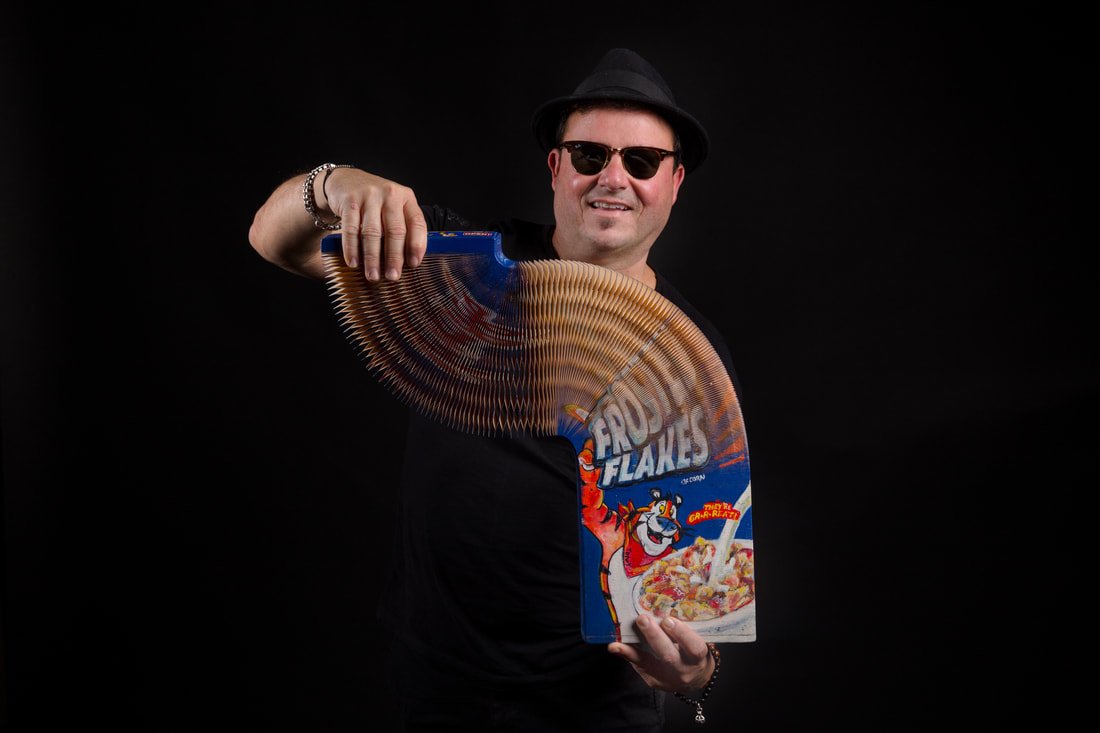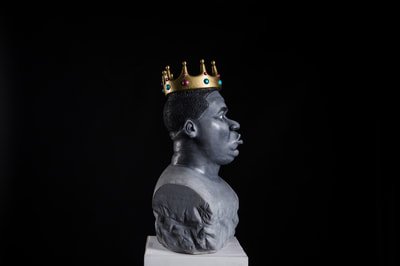Renowned Artist Felix Semper Reveals How New York Inspired Him, And How He’s Inspiring New York
Felix Semper’s shockingly stretchable art may have been exhibited in some of the most exclusive locations on the planet, but he firmly believes that their true home is on the streets. After all, placing works in public places, such as NYC’s Washington Square Park and Union Square, was how he made a name for himself. Public parks with heavy foot traffic also have another major benefit, from Semper’s point of view: They allow people who would never usually visit an art gallery to view and interact with his pieces. Few can deny that his works, which disguise extendable stacks of connected paper as commonplace objects, are thought-provoking and a compelling way to challenge perceptions, no matter their setting.
People are just as likely to find Semper’s works displayed within Rockefeller Center or on a nearby street corner, highlighting just how versatile they are. Displaying art for audiences who may typically avoid galleries can be a double-edged sword, as it subjects the pieces to a broad court of public opinion. But Semper’s practicality and unpretentiousness help him in this regard. When asked about how he reacts to critiques of his art that are far from positive, he responds, “I respect everyone’s opinion, as I hope they would respect mine. There’s always somebody. You can’t please everyone. And those are the people I target. People that have nothing to do with art. So they get offended, but soon they realize that this is a homage.” This attitude also stretches to the reactions of high-profile individuals who commission him to capture their likenesses. He highlights two conflicting responses from successful musicians. Firstly, his commission for ASAP Rocky received a less than enthusiastic response. “He’s very particular about his looks,” Semper explains, “He was fine. He said ‘Thanks for making it,’ but it’s not like ‘Oh man, I want it.’ He wasn’t crazy about it, to be honest.” On the other hand, his sculpture for Despacito singer Luis Fonsi was overwhelmingly positive. “He took it to the stage. He had a big concert, and he was singing to the sculpture. He was very pleased with his sculpture.” Semper also realizes that his work is intended for a wider audience than those who have commissioned them. And the wider world has certainly appreciated both the ASAP Rocky and the Luis Fonsi sculptures. Today, the ASAP Rocky sculpture is displayed as part of a Danish museum’s collection, and the Fonsi sculpture certainly elicited a major reaction from concertgoers who saw it.
Credit: Felix Semper
But what is it that makes Semper’s art so bold and so appealing? Semper’s most popular pieces, his paper sculptures, quite literally transform before onlookers’ eyes. Initially, they appear as typical stone sculptures or other commonplace objects, like sneakers. But when grasped and lifted, their true nature is revealed. Instead of being one solid object, they are made of hundreds of pieces of connected paper, which unfold, stretching the object to insane proportions. This style of sculpture came about due to a number of Semper’s life experiences. As a young man, Semper worked as a graphic designer in a print shop. During quiet times, he would assist with paper-cutting duties, with a hydraulic cutter. He became fascinated by the swirls and other interesting patterns the cutter would create. These patterns would remain in the back of his mind for many years, until combining with a second revelation. This second event occurred after a snowstorm, when Semper walked through three feet of settled snow. He then decided to create a sculpture from the snow, his first-ever attempt at sculpture. Semper’s wife observed this sculpture and encouraged him to pursue the discipline on a professional level. After spending some time mastering sculpting, he realized that the paper patterns of the hydraulic cutter would work to form a solid yet movable material. From this point onwards, Semper’s signature style emerged.
Two years after he decided to begin sculpting with layers of paper, Semper traveled to New York to showcase his work. During this visit, one of his pieces, named Cigar Guy, wowed passersby in Washington Square Park, and footage that people took of Semper stretching the sculpture in a seemingly impossible way went viral. Thanks to this experience, Semper realized that he needed to spend much more time in New York City. These trips would both provide inspiration and widen his profile significantly. For example, perhaps his most widely seen sculpture, of the rapper Biggie Smalls, came about from his experiences within NYC. Semper describes the inspiration as such: “I used to hang out at Union Square on Friday nights, summertime, with a whole bunch of rappers, rapping with the beats behind it. To me, it was just fascinating. I’ve always loved hip-hop, [but] this is a new phase. I saw it more like poetry. And they just came up with all these random poetry themes, just out of their minds, so quick. I went there a whole bunch of times and said, ‘You know, guys, I’m gonna create my favorite rapper, which is Biggie Smalls, and I’m gonna bring it here, and we’re all gonna rap to this.”
Credit: Felix Semper
The acclaimed Biggie Smalls sculpture would take Semper three months to craft. When it was complete, he indeed took it to Union Square. Once more, footage of this showcase went viral. This time, television talk show host Wendy Williams took notice. This led to high-end commissions, media appearances and a wide range of publicity.
Possibly the most significant people to notice Semper’s work were the family members of Biggie Smalls. The daughter of the rapper, T’yanna Wallace, personally contacted Semper, stating that they would be hosting a block party in Clinton Hill on what would have been Biggie Smalls’s birthday. Unfortunately, Semper’s schedule prevented him from attending this event, but the musician’s family has made it clear that Semper is welcome to participate in future events. However, Semper has made his own pilgrimages to areas of Brooklyn that hold significance to Biggie Smalls. For instance, he visited a street corner at Bedford Avenue and Quincy Street, where Biggie Smalls used to rap, bringing along his sculpture of the musician. While there, a number of people who were once friends of Biggie Smalls took notice and shared their stories.
Here’s a video of that:
Semper’s work has also been exhibited across New York City, both on the street and within galleries. In addition to the aforementioned locations, he has displayed his works in front of The Brooklyn Museum and The Whitney. Further afield, he’s exhibited in Miami’s Art Basel, on the streets of Los Angeles, as well as within galleries in Spain, Qatar and other far-off nations.
Wendy Williams was his first high-profile customer. She purchased a stretchable paper sculpture of a Cheez-Its box. And in addition to television hosts and musicians, his clients include the Government of the UAE and even the King of Morocco. It may seem like Semper’s career has been a whirlwind of success. Yet it took many years of hard work to get noticed. He first decided to become a full-time artist in the wake of the Global Financial Crisis in 2008. And it took almost a decade before Williams purchased an item for a significant sum.
This almost decade-long expanse of time between pursuing a full-time art career and mainstream success highlights how long-term thinking is essential for everyone of a creative mindset. Semper himself stresses that up-and-coming artists need to realize that success takes time. Specifically, he states the following: “Don’t worry about doing well or doing bad. If your work is significant enough, you will be found. Make art. Make something unique. Don’t do what anybody else is doing. Follow your heart, make art for yourself, and the rest will fall into place.”
Another angle of success that Semper has to accept is misinterpretation. This differs from criticisms of his art, in that it often misattributes the meaning of his work without directly discrediting it. A prime example is a 2018 New York Post article titled “This sculptor’s crazy, cool work will destroy the Slinky for your kids.” As Semper’s inspiration from his years of working in a print shop highlights, the Slinky has little to do with his work. But he’s candid about why the press describes his work in this way: “They’re all looking for sensationalism and things like that. That’s just how it is. I don’t pay attention to that. I try to be positive, and I try to focus on the positive things, because if you try to focus on the negativity, you drop everything and become a beach bum. It doesn’t matter to me. It does behave similar to a slinky, but it’s a totally different concept.”
In recent years, Semper’s work has become ever more complex and has incorporated other materials. For example, he once purchased a 50s-era TV from an antique shop and inserted a paper sculpture within this, with the paper stretching with the aid of a motor. This specific piece was the one later purchased by the King of Morocco. In fact, his work is also adapting to digital innovations, such as a moving NFT of himself transformed into a lion character while stretching out one of his artworks. This keenness to adopt new mediums highlights how Semper is versatile while he retains an attitude of producing art for people who may otherwise be excluded. Initially, an NFT artwork may not appear to evoke this attitude, but as Semper sees it, NFTs provide an opportunity for people to purchase his art at an affordable rate. In many ways, he’s using NFTs much as artists have long used original prints, by producing a limited number of pieces at a lower rate. This results in work that is still unique yet much more accessible in this instance.
Felix Semper’s career highlights how individual New York City neighborhoods can create ripple effects of creativity. By drawing inspiration from and honoring Clinton Hill’s Biggie Smalls, Semper was able to find international success. And he’s done this in a way that honors this inspiration. Perhaps what’s most impressive about Semper’s art is that he’s able to make people think about their favorite musicians and items in new ways. By frequently displaying his art in public places, Semper actively encourages this activity, challenging the perceptions of those who otherwise may never have seen his work. It’s almost certain that, by doing this, Semper himself will inspire others into creating their own art that redefines the way people see the world. Essentially, that’s how the cultures of communities such as Clinton Hill shape society.


























